No. Offering solids before their digestive tract is ready can result in serious health conditions, such as allergies, micronutrient deficiencies, malabsorption, constipation, diarrhea, vomiting and more, depending on the food ingested.
Baby Feeding Chart: Recommendations for the First Year of Life
By: Dr. Maria Cerino - October 18, 2023 - 12 Minute Read
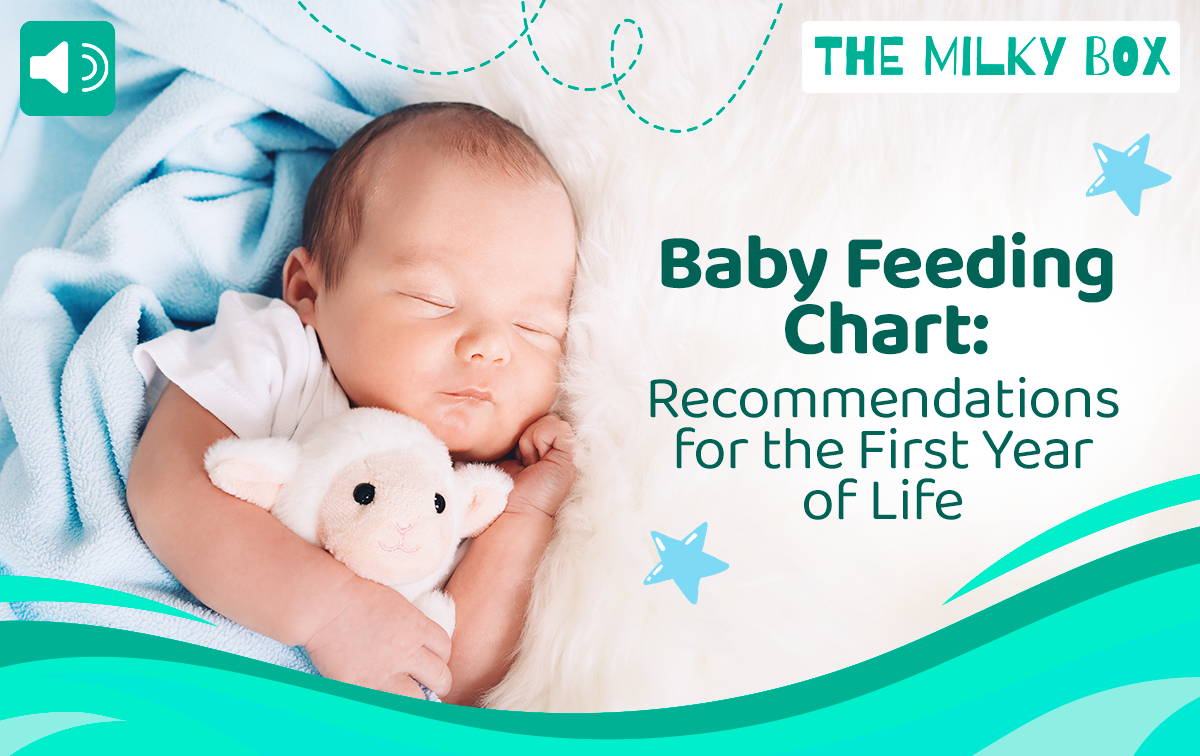
If you are a newbie parent, you might be experiencing what many of us have experienced before: an overload of information about the things we should or shouldn’t do when taking care of our little ones. Formula or breast milk? Is organic the way to go? Should I go down the soy route?
In this article, we will condense everything you need to know about nutrition so you can make the right choices during your first year of life.
Table of Contents:
1. Recommended Feeding Guide for the First Year
2. Guide for Breastfeeding (0 - 12 months)
3. Guide for Formula Feeding (0 - 12 months)
4. Best Baby Formula
5. Baby Bottle Feeding Schedule
6. How to Tell Whether Your Baby is Getting Enough Milk?
7. How to Get On a Feeding Schedule
8. Complementary Feedings With Solid Foods
10. Frequently Asked Questions
Recommended Feeding Guide for the First Year
One of the key recommendations provided by health authorities is to exclusively breastfeed a baby for the first six months of their life. Breastfeeding offers a range of benefits for infants, including protection against infections, allergies, and other health issues.
Moreover, breastfeeding can promote bonding between the mother and child and help the mother recover from childbirth more quickly. While there are different opinions on various health recommendations, the consensus on the importance of exclusive lactation during the first six months of a baby's life is widely accepted.
Breastfeeding Alternative for Infants
While breast milk is the ideal choice for infants, baby formula is a widely accepted alternative when formulated with high-quality ingredients and enriched with all necessary vitamins when exclusive breastfeeding is not possible for one reason or another.
Breastfeeding Alternative over 6 Months
Whether breastfeeding, formula feeding, or a combination of both after six months of age, you may notice some changes in your little one's eating habits. It is at this time when feeding your little one may become confusing at the least and often overwhelming.
The following sections will examine each stage closely and provide recommendations for a smooth transition. We aim to increase your confidence in meeting your little one's nutritional requirements and ensuring healthy growth and development.
Guide for Breastfeeding (0 - 12 months)
A way to look at this is to consider breast milk as a base. During the first six months, it will be the sole source of their nutrients. Breast milk is perfect for infants because it adapts to nutritional needs while providing antibodies and immunoglobulins that will become extremely valuable to build immunity in childhood.
Some mothers are lucky enough to produce the right amount of milk needed naturally, and for others, it takes a little more time to get there, but it’s important to remember that there is no shame in this process. Each mother’s body adapts differently to high-stress situations like pregnancy and childbirth and some women may need to supplement breastmilk with formula for one reason or another.
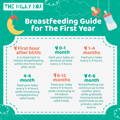
Breastfeeding Guide
If you’re about to start breastfeeding your baby, you’ll likely have many questions at the beginning. Breastfeeding should be started during the first skin-to-skin contact with the mother. If your baby is born without any complications, you will get to hold your baby and get started right away.
For the first few days after childbirth, your milk will vary in look and consistency. The first milk produced by a mother is called “Colostrum.” It’s thicker and more concentrated, and its color can vary from yellow or orange to colorless.
Colostrum is often referred to by others as liquid gold due to its high antibody content that will support your baby’s immune system.
Early Stage Breast Milk: Colostrum
After the first few days, your milk will turn white, and your little one’s feeding will begin to take on a pattern. There is a good rule of thumb to get the feeding times just right:
● 0-1 month: During the first month, you should feed your baby on demand, at least every 2-3 hours. This means that you should look for hunger cues, such as rooting, sucking on fists, or crying, and offer your breast or a bottle. It's important to feed your baby as soon as possible after they show these signs of hunger, as this helps them feel secure and satisfied.
● 1-4 months: As your baby grows, they may start to establish a more predictable feeding pattern. You should aim to feed your baby every 3-4 hours, but still follow their hunger cues if they need to eat more frequently. If you're breastfeeding, your baby may take longer to feed, but they'll also get more milk at each feeding.
● 4-6 months: At around 4-6 months, you can start introducing complementary solid foods to your baby's diet. This means offering pureed or mashed foods, such as cooked vegetables, fruits, or grains. You should continue to breastfeed or offer formula at every feeding, but also offer these solid foods once or twice a day. You can feed your baby every 3-4 hours but be flexible and follow their cues.
● At 12 months, solids can become their primary source of caloric intake, and there is no need to keep them on a breastfeeding schedule for longer.
All babies will require overnight feeding. It will be necessary to respond to their hunger prompts and provide feedings in a calm, relaxed environment.
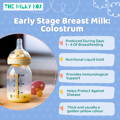
Guide for Formula Feeding (0 - 12 months)
When it comes to discussing formula feeding, we love to make a point of being realistic. Often, external circumstances will be harder to control, and therefore, many mothers will need some extra help during feedings. This is where the baby formula becomes your ally.
Formula feeding allows mothers to receive help from partners and other family members, as well as it’s sometimes necessary due to work commitments, making traveling much easier and more. It’s also very important to choose a formula suitable for their age and their nutritional needs, as well as consider dietary restrictions.
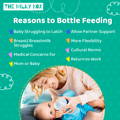
Best Baby Formula
When deciding what formula will be best for your baby, you need to check the quality of the ingredients as well as the composition to ensure your baby is meeting milestones in both growth and health. Feeding your baby, the right nutrition is critical for optimal health and development.
Baby Formula Ingredients
European Organic Formulas can be an excellent choice for parents who want to ensure their baby receives natural, ethically sourced, high-quality ingredients. These formulas are free from unwanted additives and chemicals that can harm your baby's health.
In contrast, American baby formulas may contain toxic and worrisome additives that can negatively impact your baby's well-being. These additives can include synthetic preservatives, artificial flavors, and genetically modified organisms (GMOs) having both short-term and long-term effects on your baby's health, including developmental issues, allergies, and chronic illnesses.
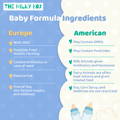
Baby Bottle Feeding Schedule
It’s recommended for formula feeding during the first three months to not adhere to a schedule but to focus on recognizing your baby's hunger cues instead. Luckily, most formulas come with a chart on the label that describes the number of ounces needed per feeding as well as the preparation instructions. We have included a quick feeding guide of the most commonly recommended schedule and portions:
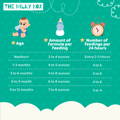
As always, it’s important to remember that when switching from breastmilk to formula or making decisions regarding their diet, you need to check with your qualified practitioner just to make sure it fits your baby’s situation and developmental needs .
How to Tell Whether Your Baby is Getting Enough Milk?
It is essential to pay attention to certain signs when feeding your baby, particularly during intervals. It is crucial to monitor their activity during resting periods to determine if they are hungry. Here are some of the most typical indications that your baby may not be receiving enough milk:
● Baby seems sleepy and lethargic: you will notice his sleeping time getting longer and longer
● Baby has not regained any of his birth weight by 10 or 14 days
● Baby is gaining weight slowly, and is falling behind on the baby growth chart according to their age
● Baby is not pooping enough (they should have 3-4 bowel movements per day)
● Baby takes too little time eating (falls asleep right after a couple of minutes of feeding)
● Latching is painful for you
It’s super important to mention that all babies react differently to feeding, and it takes a few tries to identify those signs. It’s normal and expected for parents to be unsure during the first few weeks. It’s a huge learning curve, but it’s always useful to contact a physician if you’re feeling lost.

How to Get on a Feeding Schedule
When creating a feeding schedule, it’s important to keep in mind that every baby will have different needs. It’s necessary to tailor all recommendations accordingly.
Babies vary in their needs, especially when a big part of their hunger state depends on the milk they’re feeding on. Some mother’s milk has a higher calorie content and the same goes for formula. Each baby individually adapts according to their metabolic rate and the amount of energy they receive.
During their first weeks of life, a feeding schedule is not recommended. A lot of research has shown that babies experience fluctuations in their energy requirements, particularly when they’re just getting started.
Feeding on cues makes it easier for infants to increase or decrease their intake as needed. If you set a feeding schedule that’s too far apart, you risk dehydration or malnourishment. It’s why it’s recommended both by traditional and Western medicine to refrain from feeding them on schedule.
As they grow older, you’ll learn to pick up on their hunger cues and notice the pattern, making it easier to develop an intuitive feeding schedule. This is often called responsive feeding, a way to allow your baby to learn to pick up on their hunger cues from early on.
Responsive feeding has also been positively linked with less tendency to overeat, less emotional overeating in later stages of life, and reduced risk of being overweight.
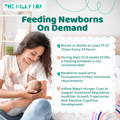
Complementary Feedings with Solid Foods
Once your baby turns six months old, a new world will open for you and them. Some babies take a little longer to be ready for solids, but there are a few crucial motor and developmental skills to observe. Being able to sit up alone or with support, proper control of their head and neck, opening their mouth when food is offered, bringing objects to mouth, and improved grabbing.
Starting with solids can often be intimidating but there are a few easy rules to follow when you’re just getting started:
● Start with small amounts of food, at first one teaspoon will be enough to let them taste new foods
● Introduce them slowly to new foods, and you can start one new food every few feedings, if you’d like to explore the baby-led weaning route, here’s everything you need to know about it.
● Avoid adding sugar to enhance flavor
● Avoid the use of excessive amounts of salt
● Avoid all fruit juices during their first year, as their sugar content can lead to tooth decay
● Introduce solid foods in a calm feeding environment where your baby is upright and is appropriately supported and moderately hungry.
At around six months, you can start with single vegetables and fruits. They need to be soft-cooked or chopped to improve their texture. Here are a few examples: porridge, sweet potato, carrot, mashed peas, apples, pears, peaches, and eggs.
You can also introduce them to some healthy packaged foods made for them. Fruit purees, infant cereal, mashed veggies, or softly cooked proteins are okay for when you’re on the go. The key is to look for healthy ingredients, no artificial colorings or flavorings, and natural sources.
A fantastic example is Holle’s Organic Fruit Porridge: it’s lactose-free, free from added sugars, sodium, and lactose, and enriched with B1 vitamin (great for brain development!). They carry a great line of age-appropriate porridge for those busy mornings. It’s a great way to speed things up while providing top-quality nutrition and natural ingredients.
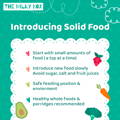
How to Tell If Your Baby Is Still Hungry?
If you’ve been following all the necessary recommendations, but you still worry if your baby is eating enough, don’t worry. We’ve all been there multiple times. It’s only natural to worry when you’re a good parent!
Here are some cues you can check out if you’re worried about them:
● Putting their fingers into their mouth
● Become restless and fidgety
● Seeking out and looking/ ‘rooting’ for a feed
● Opening their mouth
● Clenching their hands
● Crying or Fussy
If you notice these signs, you can play it by ear and offer a little snack between meals or increase their portions by a couple of tablespoons at a time. Eventually, they will learn to recognize their hunger cues and eat enough for them.
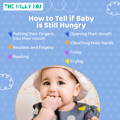
In Conclusion…
The world of baby nutrition might seem intimidating at first, but it’s easy to see it as a two-phase plan: first, you start with breastfeeding, formula or both and once they hit the six-month mark, you begin introducing solids slowly. It’s important to remember you’ll be responsible for introducing them to the delicious world of food, and you must offer variety and be patient with their process.
It is recommended to seek the advice of a qualified practitioner with regards to nutritional requirements. The Milky Box, our team of European Baby Formula experts, is also available to assist in making informed decisions.
Frequently Asked Questions
Can my baby try little bites of my food before six months?
Is breast milk the same after pumping?
Yes! If stored in the right conditions and following the health and safety guidelines by the CDC, it offers all the benefits your baby needs. It’s a perfect way to allow someone else to help you with the feedings when some well-deserved rest is needed.
What is baby-led weaning? Should I go down that route?
Baby-led weaning is a method to introduce foods to your baby after the sixth-month mark. It focuses on allowing them to explore foods at their own pace and integrating them into the dinner table early. If you’d like a more complete analysis of it, we covered it in an in-depth article about it. Ultimately, every parent can make a decision based on their personal needs, preferences, and family styles.
Should I start giving my baby water at the same time as food?
Yes. You can introduce it after six months of age, but you need to be very careful about it, especially if their main source of caloric intake is still formula or breast milk. The amount they need changes depending on their age, but here we have a great guideline on how to get started.
Are there any criteria to choose a formula that’s as close as possible to my own milk?
Mixing formula and breast milk is a happy medium for a lot of moms. A lot of parents are leaning towards the Organic European Formula route due to its higher standards in production as well as its ethically sourced, natural ingredients.
References
1. Tylka TL, Lumeng JC, Eneli IU. 2015. Maternal intuitive eating as a moderator of the association between concern about child weight and restrictive child feeding. Appetite 95:158-65.
2. Jani R, Mallan KM, Daniels L.2015. Association between Australian-Indian mothers’ controlling feeding practices and children’s appetite traits. Appetite 84:188-95
Disclaimer:
Please be aware that this information is based on general trends in babies, and it is not medical advice. Your doctor should be your first source of information and advice when considering any changes to your child’s formula and when choosing your child’s formula. Always consult your pediatrician before making any decisions about your child’s diet or if you notice any changes in your child.
Breastfeeding is the best nutrition for your baby because breast milk provides your child with all the essential nutrients they need for growth and development. Please consult your pediatrician if your child requires supplemental feeding.

Dr. Maria Cerino is a medical doctor and a researcher from Mexico, her works being published in prestigious journals like the American Journal of Human Biology among others. As a medical writer, Dr. Cerino focuses on infant nutrition and healthy neurological development in infants and children. In her free time, she enjoys going on walks, watching indie films, and cooking at home.
Read Next:
Reviewed by Dr. Eric Wood, ND, MA

Dr. Wood is a licensed naturopathic doctor, with a doctorate degree from the Canadian College of Naturopathic Medicine in Toronto, Canada. He received his post-graduation certification in Mind Body Medicine at Harvard University.
With 15 years of experience, Dr. Wood is an Associate Professor of Holistic Nutrition at the American College of Health Sciences in Portland, Oregon. Dr. Wood is an educator, clinician, author, media figure, consultant, and owns his own holistic (naturopathic) medical practice in Ft. Lauderdale, Florida. Dr. Wood is currently researching and drafting books on cancer and pediatrics.
Outside of the medical profession, Dr. Wood loves singing with the Miami Lyric Opera and is an avid musician in South Florida. He also loves spending time with his wife and kids.

